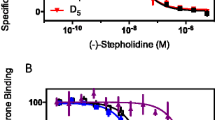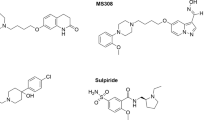Abstract
This study aims to determine the effect of the novel D3 dopamine receptor agonist, D-264, on activation of D3 and D2 dopamine receptor signal transduction pathways and cell proliferation. AtT-20 neuroendocrine cells stably expressing human D2S, D2L, and D3 dopamine receptors were treated with D-264 and the coupling of the receptors to mitogen-activated protein kinase (MAPK) and G protein-coupled inward rectifier potassium (GIRK) channels was determined using Western blotting and whole-cell voltage clamp recording, respectively. D-264 potently activated MAPK signaling pathway coupled to D2S, D2L, and D3 dopamine receptors. The activation of MAPK was more pronounced than the reference agonist quinpirole and was longer lasting. D-264 also activated GIRK channels coupled to D2S, D2L, and D3 receptors. In addition, D-264 dose-dependently induced cell proliferation in AtT-D2L and AtT-D3 cells. These results indicate that D-264 robustly activates GIRK channels and MAPK coupled to D2 and D3 dopamine receptors in AtT-20 cells. D-264 is also a potent inducer of cell proliferation.






Similar content being viewed by others
References
Birkmayer W, Hornykiewicz O (2001) The effect of l-3,4-dihydroxyphenylalanine (=DOPA) on akinesia in parkinsonism. 1961. Wien Klin Wochenschr 113:851–854
Biswas S, Hazeldine S, Ghosh B, Parrington I, Kuzhikandathil E, Reith ME, Dutta AK (2008a) Bioisosteric heterocyclic versions of 7-{[2-(4-phenyl-piperazin-1-yl)ethyl]propylamino}-5,6,7,8-tetrahydronaphth alen-2-ol: identification of highly potent and selective agonists for dopamine D3 receptor with potent in vivo activity. J Med Chem 51:3005–3019
Biswas S, Zhang S, Fernandez F, Ghosh B, Zhen J, Kuzhikandathil E, Reith ME, Dutta AK (2008b) Further structure activity relationships study of hybrid 7-{[2-(4-phenyl-piperazin-1-yl)-ethyl]-propyl-amino}-5,6,7,8-tetrahydro-naphthalen-2-ol analogues: identification of a high affinity D3-preferring agonist with potent in vivo activity with long duration of action. J Med Chem 51:101–117
Civelli O, Bunzow JR, Grandy DK (1993) Molecular diversity of the dopamine receptors. Annu Rev Pharmacol Toxicol 33:281–307
Clarke CE, Guttman M (2002) Dopamine agonist monotherapy in Parkinson’s disease. Lancet 360:1767–1769
Cotzias GC, Papavasiliou PS, Gellene R (1969) Modification of Parkinsonism—chronic treatment with l-dopa. N Engl J Med 280:337–345
Cussac D, Newman-Tancredi A, Pasteau V, Millan MJ (1999) Human dopamine D(3) receptors mediate mitogen-activated protein kinase activation via a phosphatidylinositol 3-kinase and an atypical protein kinase C-dependent mechanism. Mol Pharmacol 56:1025–1030
Du F, Li R, Huang Y, Li X, Le W (2005) Dopamine D3 receptor-preferring agonists induce neurotrophic effects on mesencephalic dopamine neurons. Eur J Neurosci 22:2422–2430
Dutta AK, Le W (2006) Existing Dopaminergic Therapies for Parkinson’s Disease. Expert Opin Ther Patents 16:1613–1625
Emilien G, Maloteaux JM, Geurts M, Hoogenberg K, Cragg S (1999) Dopamine receptors—physiological understanding to therapeutic intervention potential. Pharmacol Ther 84:133–156
Foley P, Gerlach M, Double KL, Riederer P (2004) Dopamine receptor agonists in the therapy of Parkinson's disease. J Neural Transm 111:1375–1446
Giros B, Martres MP, Sokoloff P, Schwartz JC (1990) Gene cloning of human dopaminergic D3 receptor and identification of its chromosome. C R Acad Sci III 311:501–508
Hetman M, Kanning K, Cavanaugh JE, Xia Z (1999) Neuroprotection by brain-derived neurotrophic factor is mediated by extracellular signal-regulated kinase and phosphatidylinositol 3-kinase. J Biol Chem 274:22569–22580
Iida M, Miyazaki I, Tanaka K, Kabuto H, Iwata-Ichikawa E, Ogawa N (1999) Dopamine D2 receptor-mediated antioxidant and neuroprotective effects of ropinirole, a dopamine agonist. Brain Res 838:51–59
Impey S, Obrietan K, Wong ST, Poser S, Yano S, Wayman G, Deloulme JC, Chan G, Storm DR (1998) Cross talk between ERK and PKA is required for Ca2+ stimulation of CREB-dependent transcription and ERK nuclear translocation. Neuron 21:869–883
Johnson M, Antonio T, Reith ME, Dutta AK (2012) Structure–activity relationship study of N(6)-(2-(4-(1H-Indol-5-yl)piperazin-1-yl)ethyl)-N(6)-propyl-4,5,6,7-tetrahydroben zo[d]thiazole-2,6-diamine analogues: development of highly selective D3 dopamine receptor agonists along with a highly potent D2/D3 agonist and their pharmacological characterization. J Med Chem
Joyce JN (2001) Dopamine D3 receptor as a therapeutic target for antipsychotic and antiparkinsonian drugs. Pharmacol Ther 90:231–259
Joyce JN, Millan MJ (2007) Dopamine D3 receptor agonists for protection and repair in Parkinson’s disease. Curr Opin Pharmacol 7:100–105
Kebabian JW, Calne DB (1979) Multiple receptors for dopamine. Nature 277:93–96
Kuzhikandathil EV, Bartoszyk GD (2006) The novel antidyskinetic drug sarizotan elicits different functional responses at human D2-like dopamine receptors. Neuropharmacology 51:873–884
Kuzhikandathil EV, Oxford GS (1999) Activation of human D3 dopamine receptor inhibits P/Q-type calcium channels and secretory activity in AtT-20 cells. J Neurosci 19:1698–1707
Kuzhikandathil EV, Yu W, Oxford GS (1998) Human dopamine D3 and D2L receptors couple to inward rectifier potassium channels in mammalian cell lines. Mol Cell Neurosci 12:390–402
Kuzhikandathil EV, Westrich L, Bakhos S, Pasuit J (2004) Identification and characterization of novel properties of the human D3 dopamine receptor. Mol Cell Neurosci 26:144–155
Li C, Biswas S, Li X, Dutta AK, Le W (2010) Novel D3 dopamine receptor-preferring agonist D-264: evidence of neuroprotective property in Parkinson’s disease animal models induced by 1-methyl-4-phenyl-1,2,3,6-tetrahydropyridine and lactacystin. J Neurosci Res 88:2513–2523
Lopez A, Munoz A, Guerra MJ, Labandeira-Garcia JL (2001) Mechanisms of the effects of exogenous levodopa on the dopamine-denervated striatum. Neuroscience 103:639–651
Marsden CD, Parkes JD (1976) “On–off” effects in patients with Parkinson’s disease on chronic levodopa therapy. Lancet 1:292–296
Paulus W, Jellinger K (1991) The neuropathologic basis of different clinical subgroups of Parkinson’s disease. J Neuropathol Exp Neurol 50:743–755
Plummer HK 3rd, Dhar MS, Cekanova M, Schuller HM (2005) Expression of G-protein inwardly rectifying potassium channels (GIRKs) in lung cancer cell lines. BMC Cancer 5:104
Ramirez AD, Wong SK, Menniti FS (2003) Pramipexole inhibits MPTP toxicity in mice by dopamine D3 receptor dependent and independent mechanisms. Eur J Pharmacol 475:29–35
Rascol O, Brooks DJ, Brunt ER, Korczyn AD, Poewe WH, Stocchi F (1998) Ropinirole in the treatment of early Parkinson’s disease: a 6-month interim report of a 5-year levodopa-controlled study. 056 Study Group. Mov Disord 13:39–45
Rinne UK, Bracco F, Chouza C, Dupont E, Gershanik O, Marti Masso JF, Montastruc JL, Marsden CD (1998) Early treatment of Parkinson’s disease with cabergoline delays the onset of motor complications. Results of a double-blind levodopa controlled trial. The PKDS009 Study Group. Drugs 55(Suppl 1):23–30
Sherer TB, Betarbet R, Greenamyre JT (2001) Pathogenesis of Parkinson’s disease. Curr Opin Investig Drugs 2:657–662
Sokoloff P, Giros B, Martres MP, Bouthenet ML, Schwartz JC (1990) Molecular cloning and characterization of a novel dopamine receptor (D3) as a target for neuroleptics. Nature 347:146–151
Strange PG (1993) New insights into dopamine receptors in the central nervous system. Neurochem Int 22:223–236
Sunahara RK, Guan HC, O'Dowd BF, Seeman P, Laurier LG, Ng G, George SR, Torchia J, Van Tol HH, Niznik HB (1991) Cloning of the gene for a human dopamine D5 receptor with higher affinity for dopamine than D1. Nature 350:614–619
Van Tol HH, Bunzow JR, Guan HC, Sunahara RK, Seeman P, Niznik HB, Civelli O (1991) Cloning of the gene for a human dopamine D4 receptor with high affinity for the antipsychotic clozapine. Nature 350:610–614
Werner P, Hussy N, Buell G, Jones KA, North RA (1996) D2, D3, and D4 dopamine receptors couple to G protein-regulated potassium channels in Xenopus oocytes. Mol Pharmacol 49:656–661
Westrich L, Kuzhikandathil EV (2007) The tolerance property of human D3 dopamine receptor is determined by specific amino acid residues in the second cytoplasmic loop. Biochim Biophys Acta 1773:1747–1758
Winner B, Desplats P, Hagl C, Klucken J, Aigner R, Ploetz S, Laemke J, Karl A, Aigner L, Masliah E, Buerger E, Winkler J (2009) Dopamine receptor activation promotes adult neurogenesis in an acute Parkinson model. Exp Neurol 219:543–552
Wooten GF (1997) Movement Disorders. Neurologic principles and practice. McGraw-Hill, New York
Xia Z, Dickens M, Raingeaud J, Davis RJ, Greenberg ME (1995) Opposing effects of ERK and JNK-p38 MAP kinases on apoptosis. Science 270:1326–1331
Acknowledgments
This work is supported by the National Institute of Neurological Disorders and Stroke/National Institute of Health (NS047198, AKD) and the F.M. Kirby Foundation (EVK).
Author information
Authors and Affiliations
Corresponding author
Rights and permissions
About this article
Cite this article
Kuzhikandathil, E.V., Cote, S., Santra, S. et al. Interaction of D3 preferring agonist (−)-N 6-(2-(4-(biphenyl-4-yl)piperazin-1-yl)ethyl)-N 6-propyl-4,5,6,7-tetrahydrobenzo[d]thiazole-2,6-diamine (D-264) with cloned human D2L, D2S, and D3 receptors: potent stimulation of mitogen-activated protein kinases and G protein-coupled inward rectifier potassium channels. Naunyn-Schmiedeberg's Arch Pharmacol 386, 97–105 (2013). https://doi.org/10.1007/s00210-012-0811-6
Received:
Accepted:
Published:
Issue Date:
DOI: https://doi.org/10.1007/s00210-012-0811-6




